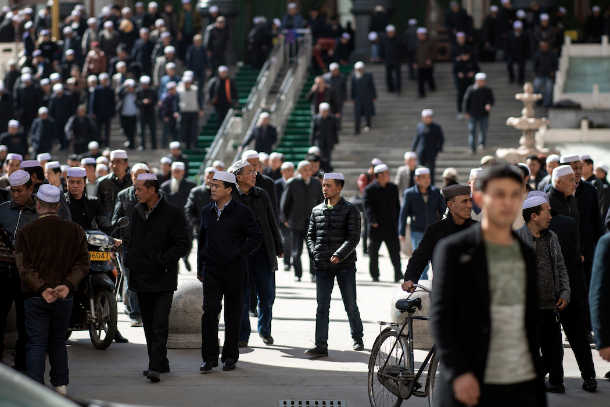
This picture taken on March 2, shows ethnic Hui Muslim men leaving Laohuasi Mosque after Friday prayers in Linxia, China's Gansu province. (Photo by Johannes Eisele/AFP)
The Chinese Communist Party's crackdown on Islam is extending beyond western Xinjiang province, home to the repressed ethnic Muslim Uyghurs, and across the country to 10.5 million ethnic Hui Muslims, as well as to other minorities who have lived in China for millennia.
The latest crackdown is an integral part of Chinese President Xi Jinping's war on religion that kicked off in 2015.
It was inked into the Party's official platform during China's five-year Congress last October that handed Xi, who also serves as chairman of the Central Military Commission, a second term as secretary-general, a role from which most of his power derives.
Following the Congress, tougher rules on religion were implemented on Feb. 1 across the so-called "Quran Belt" that stretches across four northwestern provinces including Xinjiang, Gansu, Qinghai and Ningxia.
Now many Muslims in this region are beginning to feel its effects.
The essence of Xi's plan is to sinicize the "Western" religions of Christianity and Islam — the latter of which has survived in China far longer than Christianity.
As part of this program, the Party's United Front Work Department has forbidden minors under 16 across the Hui and Gonxiang enclaves from entering mosques.
Mosques are also being instructed to raise the national flag; new imams are being forced to register; the traditional call to prayer is being curtailed as "noise pollution"; other "Arabic" buildings have been forced to remove their distinctive onion-shaped domes; and Arabic classes have been cancelled or banned from schools in the region.
The Hui heartland is the Ningxia Hui Autonomous Region (NHAR), which has a population of 6 million. Another major center is Linxia City, capital of the Linxia Hui Autonomous Prefecture in Gansu.
Other Muslim minorities in the region include the Dongxiang, who also have an autonomous county in Gansu, as well as the Kazhak, Tajik and Uzbek minorities who mainly reside in Xinjiang.
Islam was introduced to China by the 3rd Caliph in 650 AD, according to historical accounts. The Hui are mostly ethnic Han Chinese who practice Islam but are set apart by the party as the second largest of its 55 officially recognized ethnic groups.

Demonstrators spit on a poster of Chinese President Xi Jinping and Chinese Communist leader Mao Zedong during a protest to denounce China's treatment of ethnic Uyghur Muslims, in Istanbul on July 5. (Photo by Ozan Kose/AFP)
The largest ethnic group is composed of Turkic Muslim Uyghurs, who once dominated Xinjiang but now number between 11 million (according to the Party) and 15 million (Uyghur American Association).
They have been subjected to numerous state-sanctioned crackdowns in recent years, with many detained in "political re-education" camps that former inmates say are little more than pro-Communist Party brainwashing facilities.
According to Beijing's White Paper on Religion issued in April there are 20.5 million Muslims in China. If true, that means their number has not changed since a 2010 census despite broader population growth.
The CIA World Factbook (www.cia.gov) puts the number of Muslims at 25 million, or 1.8 percent of 1.379 billion people, while other sources claim it is closer to 35 million.
The Chinese government has a history of downplaying the number of people who follow various religions.
For example, that same white paper also claims there were 6 million Catholics in China, which correlates to the number of members of the Party-controlled Catholic Patriotic Association.
However it omits the so-called Underground Church, a parallel movement whose members number between 3 million and 6 million, according to different estimates.
Historically, Islam was widely tolerated in China until the Qing Dynasty began persecuting Muslims. Now pundits say Islamophobia is rising again.
"Recent years have seen the normalization of online hate speech directed at Muslims. The rise of Islamophobia inside China is a product both of government action, and of the government's failure to act," writes Matt Schrader, editor-in-chief of the China Brief at the Washington D.C.-based Jamestown Foundation.
Unlike Christianity, Islam poses an existential threat to China in the form of terrorism.
Admittedly, there have been several deadly attacks by Uyghurs armed with knives in recent years. But Beijing's real fear is the radicalization of Chinese Muslims across the borders Xinjiang shares with Pakistan, Afghanistan and a number of central Asian Muslim-majority nations.
Pakistan is another thorn in the side of China.
Beijing was quick to congratulate its new prime minister, Imran Khan, after his July 25 electoral victory. State media highlighted how he pointed to China's success in overhauling its economy and improving the lot of regular people, something Khan focused his campaign rhetoric on.
Beijing is also determined to make sure Khan doesn't ditch his anti-Washington outpourings and begin tilting Pakistan back toward the U.S., a move that could affect the most expensive jewel in the crown of Beijing's Belt & Road Initiative — the $55-billion China Pakistan Economic Corridor.
Yet in northern Pakistan the ultra-conservative Taliban, an Islamic Sunni fundamentalist political movement, is still directing its war against the Afghan government. Most Chinese Muslim groups are Sunni.


